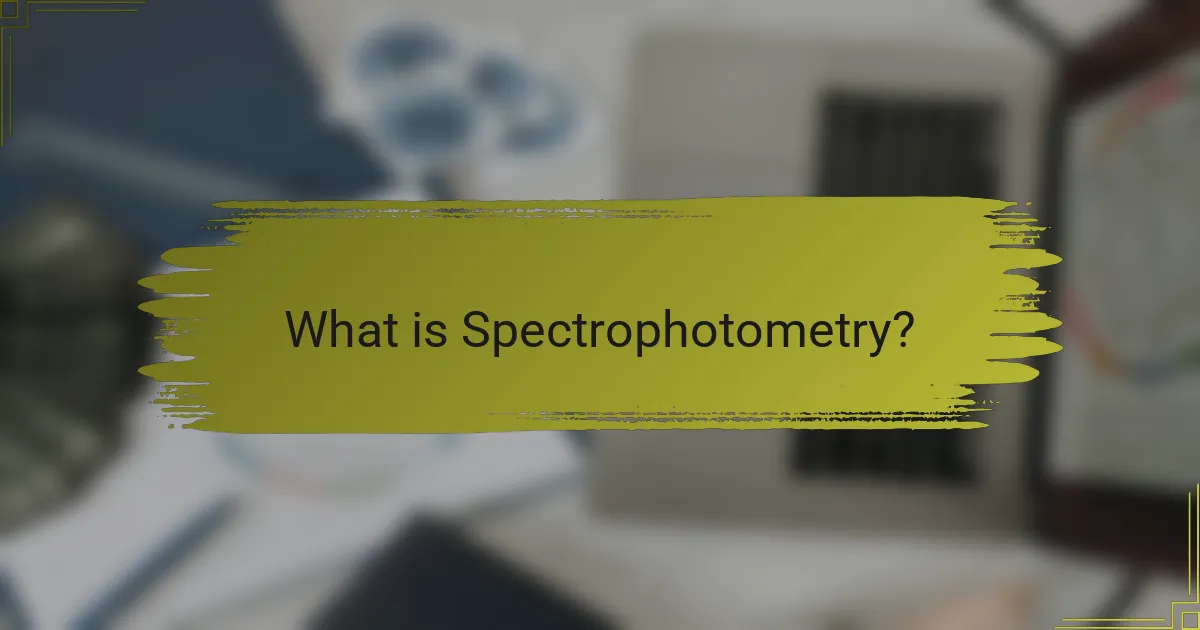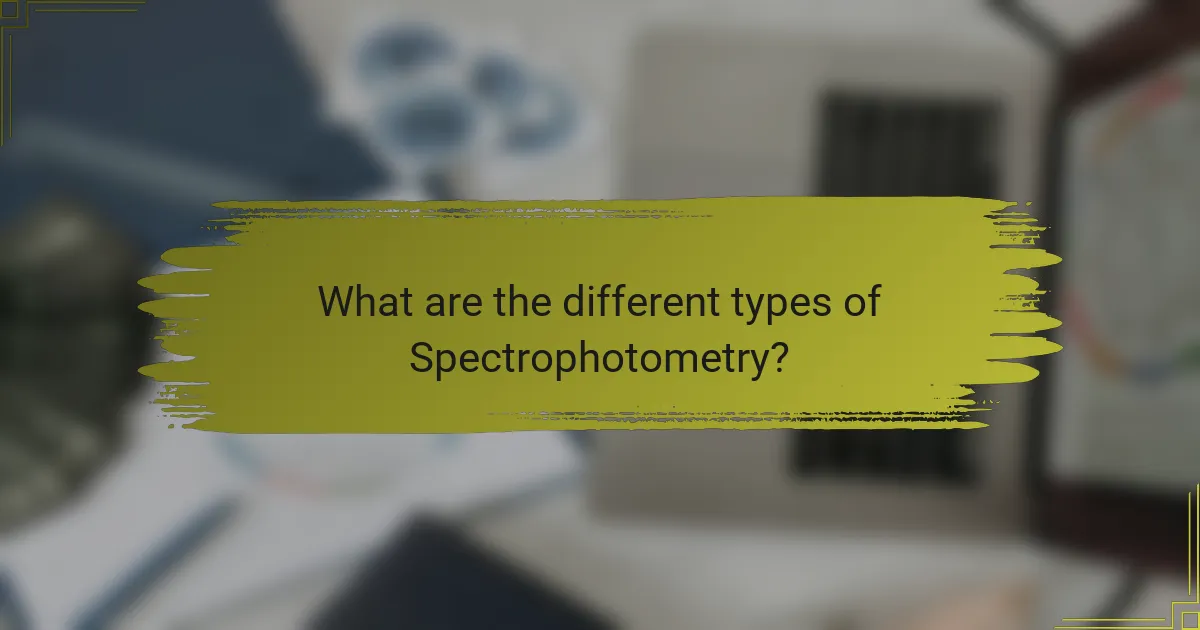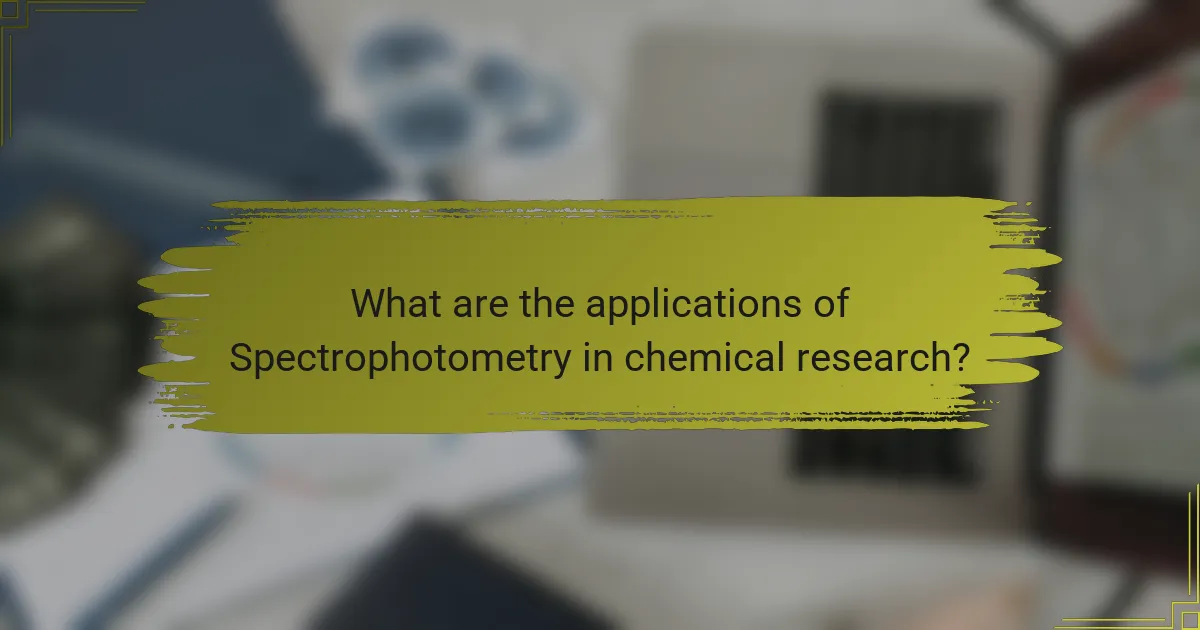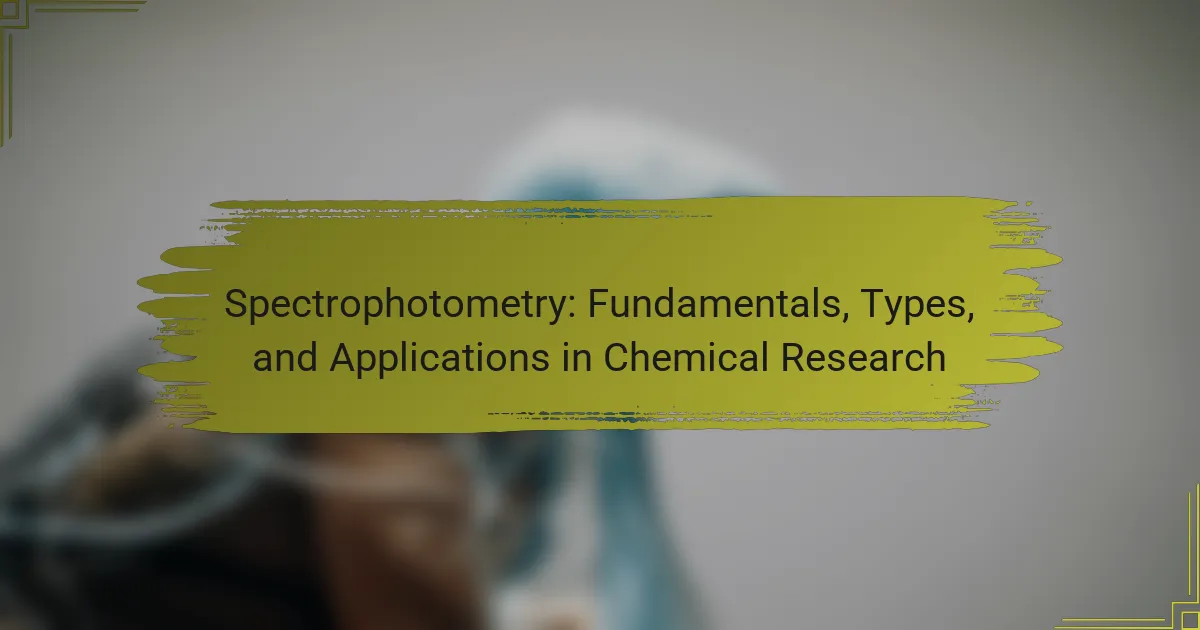
What is Spectrophotometry?
Spectrophotometry is a quantitative measurement technique used to determine the concentration of solutes in a solution. It operates by measuring the amount of light absorbed by the solution at specific wavelengths. The fundamental principle is based on Beer-Lambert Law, which states that absorbance is directly proportional to concentration. This relationship allows for the calculation of concentration from measured absorbance values. Spectrophotometry is widely used in chemical research, biology, and environmental monitoring. It provides precise and reproducible results, making it essential for analytical applications. The method can analyze various substances, including proteins, nucleic acids, and chemical compounds.
How does Spectrophotometry work?
Spectrophotometry measures the amount of light absorbed by a sample at specific wavelengths. It operates on the principle that different substances absorb light differently. A light source emits a beam of light, which passes through a monochromator. The monochromator separates the light into its component wavelengths. The selected wavelength then passes through the sample. As light travels through the sample, some wavelengths are absorbed. A detector measures the intensity of the transmitted light. The difference between the incident and transmitted light intensities indicates the absorbance. This absorbance can be correlated to the concentration of the substance in the sample using Beer-Lambert Law.
What are the key components of a spectrophotometer?
The key components of a spectrophotometer include a light source, a monochromator, a sample holder, a detector, and a readout device. The light source provides the necessary illumination for the measurement. Common light sources include tungsten lamps and xenon flash lamps. The monochromator isolates specific wavelengths of light. It typically uses prisms or diffraction gratings for this purpose. The sample holder contains the sample being analyzed. It is designed to accommodate cuvettes or other containers. The detector measures the intensity of light after it passes through the sample. Common detectors include photodiodes and photomultiplier tubes. Finally, the readout device displays the results of the measurement. It can be analog or digital, depending on the spectrophotometer design.
How do light and matter interact in spectrophotometry?
Light interacts with matter in spectrophotometry primarily through absorption, reflection, and transmission. When light passes through a sample, specific wavelengths are absorbed by the molecules present. This absorption occurs because the energy of the light matches the energy levels of electrons in the molecules. As a result, the absorbed light leads to electronic transitions within the molecules.
The amount of light absorbed is quantified using Beer-Lambert law, which relates absorbance to concentration and path length. Additionally, some light may be reflected off the surface of the sample, while the remaining light transmits through. The transmitted light can be measured to determine the concentration of the absorbing species in the sample.
This interaction forms the basis for quantitative analysis in spectrophotometry, allowing researchers to determine the concentration of substances in solution accurately.
What are the fundamental principles of Spectrophotometry?
Spectrophotometry is based on the interaction of light with matter. It measures the intensity of light absorbed by a sample. The fundamental principles include the Beer-Lambert law. This law states that absorbance is directly proportional to concentration and path length. Light of specific wavelengths is passed through a sample. The amount of light absorbed is measured and analyzed. This technique is used to quantify substances in a solution. It is widely applied in chemical research and analysis.
What role does the electromagnetic spectrum play in spectrophotometry?
The electromagnetic spectrum is fundamental to spectrophotometry. It encompasses all wavelengths of light used in the technique. Spectrophotometry measures the absorption of specific wavelengths by a sample. Different substances absorb light at different wavelengths. This absorption provides information about the chemical composition of the sample. The spectrum enables the identification and quantification of compounds. Each compound has a unique absorption spectrum. This characteristic allows for precise analysis in chemical research.
How is absorbance measured in spectrophotometry?
Absorbance in spectrophotometry is measured using a spectrophotometer. The device shines light through a sample and detects the intensity of light before and after passing through the sample. Absorbance is calculated using the formula A = log10(I0/I), where A is absorbance, I0 is the initial light intensity, and I is the transmitted light intensity. This measurement indicates how much light is absorbed by the sample. Higher absorbance values correspond to greater light absorption. Spectrophotometers are calibrated to ensure accuracy in these measurements. This method is widely used in chemical research for analyzing concentrations of substances.

What are the different types of Spectrophotometry?
The different types of spectrophotometry include UV-Vis spectrophotometry, infrared (IR) spectrophotometry, and atomic absorption spectrophotometry. UV-Vis spectrophotometry measures light absorbance in the ultraviolet and visible regions of the electromagnetic spectrum. It is commonly used for analyzing solutions in chemistry. Infrared spectrophotometry focuses on the infrared region, providing information about molecular vibrations and functional groups. Atomic absorption spectrophotometry measures the concentration of specific metal ions in a sample by analyzing light absorption of atoms. Each type serves distinct applications in chemical research, offering insights into molecular structures and concentrations.
How do UV-Vis and IR spectrophotometry differ?
UV-Vis and IR spectrophotometry differ primarily in the wavelength ranges they utilize. UV-Vis spectrophotometry operates in the ultraviolet and visible light regions, typically from 200 to 800 nm. This technique measures the absorption of light by electronic transitions in molecules. In contrast, IR spectrophotometry operates in the infrared region, generally from 4000 to 400 cm^-1 (or about 2.5 to 25 µm). It measures the absorption of light due to vibrational transitions in molecular bonds. The types of information obtained from these techniques also differ. UV-Vis is often used for determining concentrations of analytes, while IR is used for identifying functional groups and molecular structures. The instrumentation and sample preparation methods can vary significantly between the two techniques.
What applications are specific to UV-Vis spectrophotometry?
UV-Vis spectrophotometry is used in various applications including quantitative analysis of compounds. It is commonly employed in determining the concentration of substances in solutions. This technique is vital in monitoring chemical reactions. It is also used in assessing the purity of compounds. Additionally, UV-Vis spectrophotometry aids in identifying chemical species based on their absorbance spectra. The pharmaceutical industry utilizes it for drug formulation and stability testing. Environmental testing often involves measuring pollutants in water samples. Furthermore, it plays a role in biological research for analyzing proteins and nucleic acids.
What unique features does IR spectrophotometry offer?
IR spectrophotometry offers unique features such as the ability to identify molecular structures and functional groups. It operates by measuring the absorption of infrared light by a sample. This technique provides information about molecular vibrations and bond strengths. It is particularly effective for organic compounds and can distinguish between different chemical environments. IR spectrophotometry has a wide range of applications, including identifying unknown substances and monitoring chemical reactions. Its capability to analyze solid, liquid, and gas samples enhances its versatility in research. Furthermore, it requires minimal sample preparation, making it efficient for various analytical tasks.
What is the significance of fluorescence spectrophotometry?
Fluorescence spectrophotometry is significant for its ability to detect and quantify low concentrations of substances. It utilizes the principle of fluorescence, where molecules absorb light at one wavelength and emit it at a longer wavelength. This technique is highly sensitive and can measure concentrations in the nanomolar range. Fluorescence spectrophotometry is widely used in biochemical assays, environmental monitoring, and medical diagnostics. For example, it plays a crucial role in detecting biomolecules like proteins and nucleic acids. The high sensitivity and specificity make it invaluable in research and clinical applications.
How does fluorescence enhance analytical sensitivity?
Fluorescence enhances analytical sensitivity by allowing the detection of low concentrations of analytes. This occurs because fluorescent materials emit light at longer wavelengths when excited by a specific wavelength. The emitted light can be detected even when the analyte is present in trace amounts.
Fluorescence has a high quantum yield, meaning that a significant proportion of absorbed photons are re-emitted as light. This property results in a stronger signal compared to non-fluorescent methods. Additionally, fluorescence spectroscopy often utilizes filters that can selectively isolate the emitted light from background noise.
Studies show that fluorescence detection can achieve limits of detection in the nanomolar range. For example, in biochemical assays, fluorescence can detect biomolecules at concentrations as low as 1 nM. This capability makes fluorescence a powerful tool in various fields, including environmental monitoring and clinical diagnostics.
What are common applications of fluorescence spectrophotometry?
Fluorescence spectrophotometry has several common applications in various fields. It is widely used in biochemical analysis to study proteins and nucleic acids. In environmental monitoring, it detects pollutants in water and soil samples. The technique is also employed in medical diagnostics for identifying biomarkers in diseases. Additionally, fluorescence spectrophotometry is utilized in drug discovery to screen compounds for biological activity. Its applications extend to food safety testing, where it identifies contaminants and additives. In research, it aids in imaging cellular processes and tracking molecular interactions.

What are the applications of Spectrophotometry in chemical research?
Spectrophotometry is widely used in chemical research for quantitative analysis of substances. It measures the absorbance or transmittance of light by a sample. This technique helps determine concentration levels of compounds in various solutions. Researchers use it to analyze reaction kinetics and monitor changes over time. Spectrophotometry is also essential in identifying compounds through their unique absorption spectra. It plays a crucial role in environmental monitoring by detecting pollutants in water and air. Additionally, it is utilized in pharmaceutical development to assess drug purity and stability. Overall, spectrophotometry is a versatile tool in chemical research, providing critical insights and data.
How is Spectrophotometry utilized in quantitative analysis?
Spectrophotometry is utilized in quantitative analysis to measure the concentration of solutes in a solution. It works by analyzing the absorbance of light at specific wavelengths. The Beer-Lambert Law describes this relationship, stating that absorbance is directly proportional to concentration. This law is mathematically represented as A = εlc, where A is absorbance, ε is the molar absorptivity, l is the path length, and c is the concentration. Spectrophotometers can detect minute changes in absorbance, allowing for precise quantification. Applications include determining concentrations of proteins, nucleic acids, and various chemicals in laboratory settings. This method is widely used due to its accuracy, speed, and non-destructive nature.
What are the benefits of using spectrophotometry for concentration measurements?
Spectrophotometry provides precise and accurate concentration measurements of substances in solution. This technique utilizes the absorption of light at specific wavelengths to quantify analyte concentrations. It allows for rapid analysis, often yielding results in minutes. The method is non-destructive, preserving the sample for further testing. Spectrophotometry is highly sensitive, capable of detecting low concentrations, often in the micromolar range. It is also versatile, applicable to various fields such as biochemistry, environmental monitoring, and pharmaceuticals. The Beer-Lambert Law underpins its quantitative analysis, establishing a direct relationship between absorbance and concentration. This law has been validated through extensive research, confirming the reliability of spectrophotometric measurements.
Which industries rely on spectrophotometric analysis?
The industries that rely on spectrophotometric analysis include pharmaceuticals, environmental monitoring, food and beverage, and chemical manufacturing. In pharmaceuticals, spectrophotometry is used for drug formulation and quality control. Environmental monitoring utilizes this technique to assess water and air quality. The food and beverage industry employs spectrophotometry for nutritional analysis and quality assurance. Chemical manufacturing uses it for process control and product development. Each of these industries benefits from the precision and accuracy that spectrophotometric analysis provides in their respective applications.
What role does Spectrophotometry play in quality control?
Spectrophotometry plays a crucial role in quality control by measuring the absorbance of light by a sample. This technique ensures that products meet specified standards by quantifying the concentration of substances. It is widely used in industries such as pharmaceuticals, food, and beverages. In pharmaceuticals, for instance, spectrophotometry helps verify the concentration of active ingredients. This verification is essential for maintaining product efficacy and safety. The precision of this method allows for the detection of even minor deviations from established norms. Additionally, spectrophotometry can be employed for monitoring processes in real-time. This capability enhances consistency and reliability in production. Overall, spectrophotometry is integral to maintaining quality across various sectors.
How can spectrophotometry detect impurities in samples?
Spectrophotometry detects impurities in samples by measuring the absorbance of light at specific wavelengths. Each substance has a unique absorbance spectrum. Impurities will cause deviations in the expected absorbance profile. By comparing the sample’s spectrum to a reference, discrepancies indicate the presence of impurities. This method is sensitive and can detect low concentrations of contaminants. For instance, a study by W. J. Heineman and J. W. M. van der Meer demonstrated that spectrophotometry can identify trace metals in water samples effectively. Thus, spectrophotometry is a reliable technique for impurity detection in various samples.
What are the advantages of using spectrophotometry in pharmaceuticals?
Spectrophotometry offers several advantages in pharmaceuticals. It provides precise quantitative analysis of drug concentrations. This analytical technique is rapid and requires minimal sample preparation. Spectrophotometry is non-destructive, allowing for the preservation of samples. It can analyze multiple samples simultaneously, increasing efficiency. The method is cost-effective due to low operational costs. It is also highly sensitive, detecting low concentrations of compounds. Furthermore, spectrophotometry is versatile, applicable to various substances and formulations. These benefits make it a valuable tool in pharmaceutical research and quality control.
What are some best practices for using Spectrophotometry effectively?
Use clean cuvettes to avoid contamination in spectrophotometry. Contaminated cuvettes can lead to inaccurate readings. Ensure proper calibration before each measurement. Calibration ensures reliable and reproducible results. Select appropriate wavelength for the specific analyte. The correct wavelength maximizes sensitivity and accuracy. Maintain consistent sample temperature during measurements. Temperature fluctuations can affect absorbance readings. Use blank samples to zero the spectrophotometer. Blanks account for background absorbance. Regularly maintain and service the spectrophotometer. Proper maintenance extends the instrument’s lifespan and performance. Document all measurements and conditions meticulously. Accurate records facilitate reproducibility and troubleshooting.
How can one ensure accurate calibration of spectrophotometers?
Accurate calibration of spectrophotometers can be ensured by using standard reference materials. Standard reference materials have known absorbance values at specific wavelengths. These materials provide a baseline for comparison. Regularly calibrating with these standards helps maintain accuracy. It is also important to perform wavelength calibration using a monochromatic light source. This ensures that the spectrophotometer reads the correct wavelengths. Additionally, checking the instrument’s performance with blank solutions is crucial. This helps identify any baseline drift or noise. Following these steps consistently will enhance the reliability of measurements.
What common troubleshooting tips should be considered in spectrophotometric analysis?
Common troubleshooting tips in spectrophotometric analysis include checking the calibration of the spectrophotometer. Regular calibration ensures accurate measurements. Verify that the cuvettes are clean and free from scratches. Dirty or damaged cuvettes can lead to erroneous results. Confirm that the correct wavelength is selected for the analysis. Using the wrong wavelength can affect absorbance readings. Ensure that the sample concentration is within the instrument’s linear range. Exceeding this range may cause non-linear responses. Monitor the temperature of the sample and the instrument. Temperature fluctuations can impact results. Lastly, consider potential interferences from other substances in the sample. These interferences can skew the data obtained.
Spectrophotometry is a quantitative measurement technique used to determine the concentration of solutes in a solution by measuring light absorption at specific wavelengths. The article covers the fundamentals of spectrophotometry, including its principles based on the Beer-Lambert Law, key components, and the interaction of light and matter. It explores different types of spectrophotometry, such as UV-Vis and infrared, and their unique applications in chemical research, pharmaceuticals, and environmental monitoring. Additionally, the article discusses best practices for effective use, calibration, and troubleshooting in spectrophotometric analysis, highlighting its significance in ensuring accurate and reliable results across various industries.
